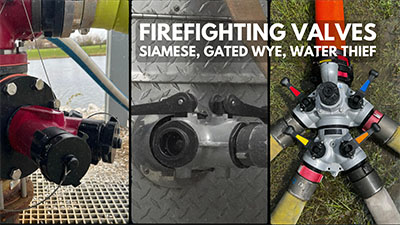Differences in Firefighting Valves: Siamese, Gated Wye, Water Thief
On the fire ground, firefighters use a lot of different equipment to move and control water. One vital piece of their water flow equipment is the different types of valves they use. If you’ve heard firefighters talk about a siamese, gated wye, manifold, or water thief, you might have wondered what they are and what the differences are. Let’s clear it up!
What is a Siamese Valve?

A siamese valve allows firefighters to combine multiple water sources into a single output. There are two or more inlets and a single outlet for distributing water. This allows firefighters to supply large amounts of water to a single source.
The siamese may or may not have valves at each inlet. Valves at each inlet give the firefighter greater control over the water flow during use but may not be needed for the scenarios they encounter. Inside of the siamese valve there may also be a clapper which can automatically adjust water flow based on whether one or multiple sources are connected.
Firefighters might use a siamese valve to supply water to an aerial apparatus, a pumper, or a high-volume ground monitor.
What is a Gated Wye?

Sometimes, firefighters have one source of water that they need to split into two or more. In this case, they may use a gated wye or water thief.
A gated wye may be used directly off of a hydrant or standpipe to supply two hose lines or may be used to split a single hose line into multiple lines. For example, if a team of firefighters are battling an apartment fire, they may run a 2.5” hose line off the standpipe and down the hallway, then use a gated wye to split the line into two 1 ¾" hose lines to attack different rooms or spaces while relying on a single water source.
A gated wye has gateable valves on each outlet, which gives the firefighter maximum control over the water flow and makes this tool extremely useful as fire ground conditions change.
Gated wyes are also common in wildland firefighting scenarios where water is needed at various points on the fire ground.
What is a Water Thief or Firefighting Manifold?

A water thief or manifold does the opposite of a siamese and allows firefighters to divide one larger water source into multiple smaller ones. This allows the firefighter to supply multiple hose lines for handline nozzles or portable monitors. This is like a gated wye but will have an inlet coupling of 2.5” or larger and several outlets.
The water thief typically has gated valves on each outlet so that the firefighter can easily control the output of water. Since this style requires a large water source, the inlet is typically a large diameter hose of 2.5” or larger.
You might see a manifold used during large-scale drafting operations or when a fire department has high flow from a hydrant and can supply multiple lines from it. Similar to the gated wye, firefighters will use a large water supply source and break that into multiple smaller sources for maximum coverage on the fire ground. Since the water thief allows larger amounts of water to flow in, it can also be used to supply a portable monitor and multiple handlines at once.
What is the benefit of these valves?
In addition to allowing firefighters to combine or split water sources to better suit their needs on the fire ground, these valves have an additional benefit: giving firefighters water flow control in the hot zone.
With each of these valves, firefighters can pre-plan and be prepared to connect additional lines without disrupting water flow in other areas. For a firefighter working with a water thief, they can easily connect an additional line in the hot zone. This may be especially useful if additional firefighters arrive on scene to assist and can connect, or if the truck supplying your line is situated further back from the scene.
Likewise, a siamese allows easy connection when a second due or other water source becomes available.
